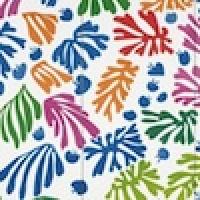
Cut-outs, curating and communicating
I was lucky enough to see the beautiful Matisse exhibition at the Tate Modern in London last week. A few days later I was asked, by a TV researcher, how do you make maths interesting and understandable to people when so many people, in her experience, had hated and avoided it at school? In response I found myself telling her about the Matisse exhibiton. Not to change the subject or avoid discussing the bad reputation maths has in many people's minds, but to explain what we at Plus, along with many other maths communicators, try to do.
Now I loved maths at school. It made sense, I could express what was in my brain and how I saw the world through maths, and I found it fun. What I found a challenge was art class, I didn't feel I had any artistic ability at all. People who could accurately draw or realistically paint people (or bowls of fruit or jugs of water...) amazed me - it was like they had a magic power. And for a long time I didn't think much of modern art. For example Picasso's pictures seemed ugly and didn't look like the things they apparently depicted, and Matisse's bright art seemed simplistic.
My opinion on art, particularly modern art, has changed, thanks particularly to two fantastic exhibitions. The first was over a decade ago at a light-filled gallery in Spain that showed many of Picasso's preliminary sketches and studies leading up to the Guernica, the full work of which filled the final room of the gallery. Following the journey that Picasso took as he built towards this huge masterpiece, along with the commentary of the social and artistic context of the piece, gave me a new appreciation of the skill, effort and genius of this work. It was awesome. I began to see all his work differently.
The Matisse show at the Tate contains many of what are called the Cut-Outs. Very late in his life, after a serious illness, he initially wasn't able to paint the huge canvases he previously produced. Instead, sitting in a chair or up in bed, he began to cut out coloured paper which he would instruct assistants to pin to the walls of his room and studio, moving it a little to the left or right, a little up or down, experimenting with these coloured shapes to build collages that had enormous power. He was so taken by this new genre he had invented that even when he recovered enough to paint he preferred this new approach.
The exhibition contains video of Matisse at work, photographs of his studio and commentary that explain the personal, artistic and social context for his work. Walking through the chronologically arranged rooms it gave me a sense of his motivation for working this way, and how it changed his perspective, and the significance of this work both artistically but also its wider cultural context. The exhibition included different types of content: recordings of the artist himself (or someone speaking his words) about his motivation, clear descriptions of the works and how they were made, explanations of the significance of this work in art, and how they interpreted Matisse's world. And most importantly, of course, was seeing the works themselves, up close, smooth curves, jagged edges, bright colours, pinned together.
It was the brilliant curation of this exhibition that reminded me and inspired me about the work we do here at Plus. We want to allow anyone a chance to see some of the wonders of mathematics up close. We hope that hearing the words of researchers will give a sense of their motivations in doing their mathematics, and we aim to show the significance of this work both in mathematics, and in a wider, cultural setting. We hope to give people a glimpse into how mathematicians perceive the world and how they use mathematics to express their perception of the world. And we hope this gives our readers a new appreciation of maths, of its power and beauty, that they might not have noticed or enjoyed before.
Now I'll never be an artist. But thanks to clever and passionate curation I have over time developed an appreciation of many different types of art, that makes seeing new art less confronting and more exciting. And sometimes, when the urge arises, I might have a go at capturing something on pencil and paper or in cut-outs of coloured paper, just for my own pleasure. I hope that Plus plays a small part in helping everyone have a similar appreciation of mathematics. We might not all be mathematicians, but I hope we can all enjoy and engage with mathematical ideas, appreciate their beauty and power. And that the next time maths pops up in our lives, it's something to be excited about, rather than avoided.
Anonymous
I share your enthusiasm about the curating of the Matisse exhibition. I just wanted to go round smiling all the time at the joy Matisse seemed to have had in discovering cut-outs. I loved the vibrant colours and the way he balanced them.
You would have a harder job in encouraging me with mathematics though I can enjoy numbers and harmony. I have a vague recollection of having one inspired maths teacher for a very short time who helped me to enjoy working out how fomulae worked.
caroline@carolinetoll.co.uk
Anonymous
Many get affraid of doing maths, but from the very beginning of doing maths, one should remember the rules as well as some laws. Just do the sum according to the laws, not need to follow same instruction and avoid to eat the math, just try to understad and remember laws.